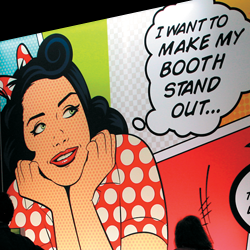 t's the night before yet another trade show on your hectic calendar. But tonight is different. You're unveiling a new booth to company brass, so it feels a little bit like opening night on Broadway. With executives standing by, you flick on the booth lights with Bob Fosse drama and flair. Ta-da! There it is. Brilliant, beautiful, and downright wicked. As you step aside and await a shower of accolades, your CEO offers an assessment.
"Decent setup you've got here," she says. "But the last time I checked, we were a health-care provider, not a 'heath-care' provider. Fix this graphics foul-up by morning, or you're fired."
As your CEO saunters off, you spot the hideous typo - a missing L on a 30-by-40-inch backlit graphic positioned front and center in your booth. Ego reduced to rubble, you call your advertising agency and order another panel for overnight delivery. The next day, you scurry around to make the last-minute change before the show - narrowly avoiding a show-floor disaster, and possibly your immediate termination.
But while the show-floor typo was a shock, the real blow comes when you add up the costs to fix it. Replacing one graphic, which originally cost only $260 to fabricate, cost you more than $3,000 to replace at the show - that's 11 times the original investment.
"How can that be?" you ask yourself, as you frantically pull out a calculator and start crunching numbers. "How can a little thing like a missing L cost more than $3,000 to fix?"
EXHIBITOR answers this age-old question with "The Cost of the Missing L." Using industry averages and graphics-house estimates, we've calculated the costs of changing a graphic panel at three different points in the pre-show process.
As the scenarios indicate, seemingly simple show-floor changes aren't that simple. After all, a trade show is a theatrical operation that involves many complex processes and workers, most of them unionized. Graphics-house rush charges and priority-delivery costs, not to mention 100-percent markups and last-minute drayage and electrical charges, multiply faster than Wesley Snipes' tax penalties.
"The Cost of the Missing L," also exposes how much you'll save if you catch the typo early in the process. After all, mistakes happen. But as the scenarios prove, the sooner you catch a mistake, the cheaper it is to fix. In this case, the difference between catching the error prior to production vs. after show-floor setup is the difference between a $140 "Oops!" and a $3,000 debacle. e
|









